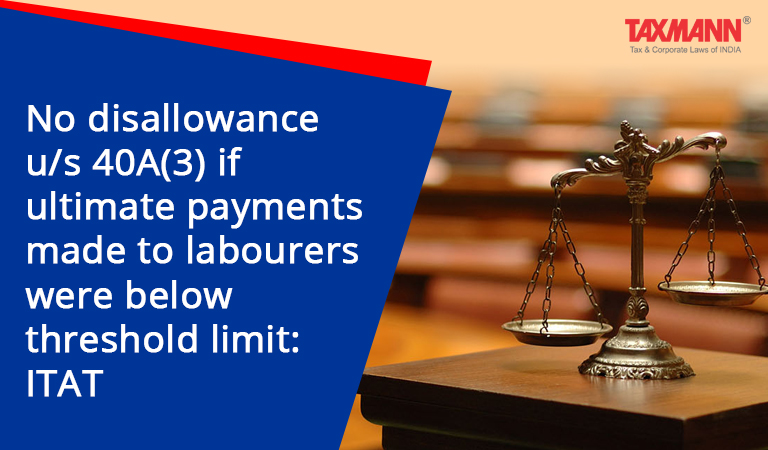No disallowance u/s 40A(3) if ultimate payments made to labourers were below threshold limit: ITAT
- Blog|News|Income Tax|
- 2 Min Read
- By Taxmann
- |
- Last Updated on 26 July, 2021
Case details: Gali Subba Raju v. ACIT - [2021] 128 taxmann.com 176 (Visakhapatnam - Trib.)
Judiciary and Counsel Details
-
- N.K. Choudhary | Judicial Member and D.S. Sunder Singh | Accountant Member.
- G.V.N. Hari, AR for the Appellant.
- Smt. Suman Malik, DR for the Respondent.
Facts of the Case
Assessee filed a return of income, and his case was selected for scrutiny. During assessment proceedings, Assessing Officer (AO) found that assessee had made a payment of Rs. 18,00,000 to labourers in cash. Consequently, AO made disallowances under Section 40A(3).
Aggrieved by order of AO, assessee preferred an appeal before CIT(A). Assessee submitted that the payment was made for expenses incurred in project sites wherein many labour charges were paid to the number of labourers working at the project sites. It was not the payment made to a single person. It was a transfer entry for labour charges paid to various workers at the site. In support of his claim, assessee produced the site ledger details of labour payments. CIT(A) examined the attendance register and ledger copy of labour charges and observed that all the payments made were below Rs. 20,000 per transaction. However, CIT(A) could not find a valid reason for paying the sum of Rs. 18,00,000 on a single day. Therefore, CIT(A) confirmed the addition made by AO.
ITAT Held
On further appeal, Vishakhapatnam ITAT held that AO did not disbelieve the genuineness of the expenditure. The grievance of AO was only for making the payment on a single day. Assessee stated that the entire payment was not made on the same day, and it was only the transfer entry of the payments made at the sites. Assessee had produced the attendance register and the acquaintance register, wherein it is seen that the payment was made to several labourers, which the recipient duly acknowledged on revenue stamp. All the payments were below Rs. 20,000 to each individual. Assessee stated that the cash payment was made at the agency area to labourers, where free mobility was unavailable.
Accordingly, ITAT held that disallowance under Section 40A(3) attracts if the assessee makes the payment in excess of Rs. 20,000 in a day to any person with regard to the expenditure incurred. Since each payment was less than Rs. 20,000, the question of application of section 40A(3) does not arise. Hence, the addition made by AO was deleted.
Disclaimer: The content/information published on the website is only for general information of the user and shall not be construed as legal advice. While the Taxmann has exercised reasonable efforts to ensure the veracity of information/content published, Taxmann shall be under no liability in any manner whatsoever for incorrect information, if any.

Taxmann Publications has a dedicated in-house Research & Editorial Team. This team consists of a team of Chartered Accountants, Company Secretaries, and Lawyers. This team works under the guidance and supervision of editor-in-chief Mr Rakesh Bhargava.
The Research and Editorial Team is responsible for developing reliable and accurate content for the readers. The team follows the six-sigma approach to achieve the benchmark of zero error in its publications and research platforms. The team ensures that the following publication guidelines are thoroughly followed while developing the content:
- The statutory material is obtained only from the authorized and reliable sources
- All the latest developments in the judicial and legislative fields are covered
- Prepare the analytical write-ups on current, controversial, and important issues to help the readers to understand the concept and its implications
- Every content published by Taxmann is complete, accurate and lucid
- All evidence-based statements are supported with proper reference to Section, Circular No., Notification No. or citations
- The golden rules of grammar, style and consistency are thoroughly followed
- Font and size that’s easy to read and remain consistent across all imprint and digital publications are applied








 CA | CS | CMA
CA | CS | CMA


